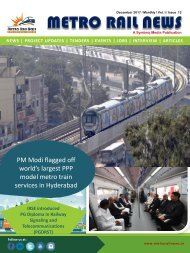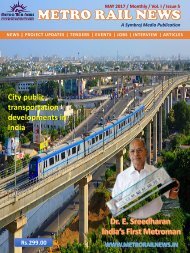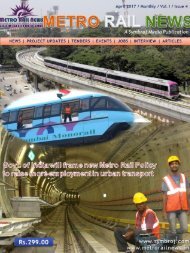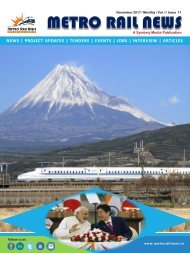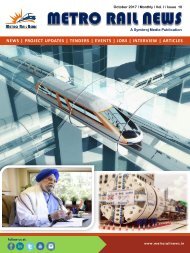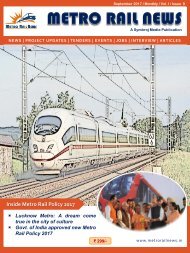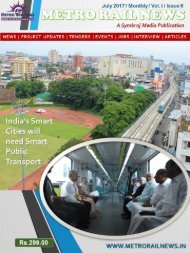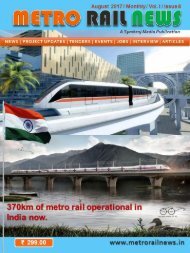Metro Rail News December 2016
You also want an ePaper? Increase the reach of your titles
YUMPU automatically turns print PDFs into web optimized ePapers that Google loves.
An agreement on the Rs 98,000<br />
crore bullet train between<br />
Mumbai and Ahmedabad is<br />
the highlight of Japanese Prime<br />
Minister Shinzo Abe’s visit to<br />
India. The project will be<br />
financed with a 50-year yen<br />
loan at 0.1 percent, which<br />
includes a moratorium on<br />
interest payments for the first<br />
20 years.<br />
<strong>Rail</strong>way Minister Suresh<br />
Prabhu’s aides say the train<br />
will be viable with rates that<br />
are one-and-a-half times the<br />
current AC first class fares, or<br />
nearly Rs 3,000. That is Rs 6<br />
per km.<br />
Viability will depend on traffic<br />
and the frequency of service.<br />
<strong>Rail</strong> officials say there is<br />
enough between the two cities:<br />
trains are chockfull and flights<br />
are packed. At 300-350 kmph,<br />
the distance should be licked<br />
in less than two hours. This<br />
will create additional demand.<br />
With quick visits possible,<br />
more people will travel.<br />
Earners might persuade their<br />
families to relocate outside<br />
expensive and congested<br />
Mumbai.<br />
Financial Rate of Return<br />
The Japanese International<br />
Cooperation Agency (JICA),<br />
the aides say, has estimated<br />
the financial rate of return at<br />
4.4 percent a year. This is less<br />
than the yield on government<br />
bonds. But the economic rate<br />
of return – or the impact on the<br />
economy – is estimated at 13<br />
percent annually.<br />
Fares alone will not be enough.<br />
Japanese bullet trains are<br />
cross-subsidised by revenue<br />
from property development.<br />
India’s bullet train corporation<br />
should be able to skim the<br />
increased land value it will<br />
create along the route through<br />
industrial enclaves and<br />
townships.<br />
The project will take two-anda-half<br />
years to plan and eight<br />
years to complete.<br />
Though Japanese financial<br />
terms seem fetching, they may<br />
not actually be so. Former<br />
railway official Ved Mani<br />
Tiwari who, until August, was<br />
director of Kochi <strong>Metro</strong> <strong>Rail</strong>,<br />
found the dollar to be the most<br />
stable over a 40-year period,<br />
with annualised volatility of<br />
4.5 percent. The currencies<br />
constituting the Euro yo-yoed<br />
by 6.5 percent while the yen<br />
swung the most at 9.5 percent<br />
annually.<br />
India May End Up Paying<br />
More<br />
If the Japanese loan for the<br />
bullet train is ‘tied’ and India<br />
can only buy Japanese<br />
equipment it might pay more<br />
than it should. Japanese<br />
electric engines for the<br />
Japanese-financed western<br />
freight corridor cost more than<br />
Rs 50 crore each. Alstom India<br />
has undertaken to supply<br />
ARTICLES |<br />
higher capacity (12,000 hp)<br />
electrical engines with<br />
maintenance thrown in from<br />
its Madhepura plant for Rs 24<br />
crore each.<br />
Making Travel Efficient<br />
As India’s economy grows and<br />
people’s income goes up, it<br />
will need an efficient way of<br />
moving large number of<br />
people quickly over long<br />
distances. It cannot depend on<br />
air travel alone for reasons of<br />
energy efficiency and climate<br />
change. Trains use one-fifth<br />
the energy of airplanes and the<br />
carbon emission per passenger<br />
is much lower.<br />
The <strong>Rail</strong>ways have already<br />
conducted studies to examine<br />
the viability of six high-speed<br />
rail routes. These are:<br />
Delhi–Chandigarh–Amritsar<br />
(450 km)<br />
Pune–Mumbai–Ahmedabad<br />
(650 km)<br />
Hyderabad–Dornakal–<br />
Vijaywada–Chennai (664 km)<br />
Chennai–Bangalore–<br />
Coimbatore–Ernakulam (649<br />
km)<br />
Howrah–Haldia (135 km) and<br />
Delhi–Agra–Lucknow–<br />
Varanasi–Patna (991 km).<br />
But if funds were finite and<br />
India had to choose between<br />
rail services that would give<br />
the biggest bang for money, it<br />
would opt for elevated 200<br />
kmph semi-high speed trains<br />
connecting the metros with<br />
satellite cities that would make<br />
quick getaways possible.<br />
<strong>Metro</strong> <strong>Rail</strong> <strong>News</strong> | <strong>December</strong> <strong>2016</strong> | www.metrorailnews.in 41






